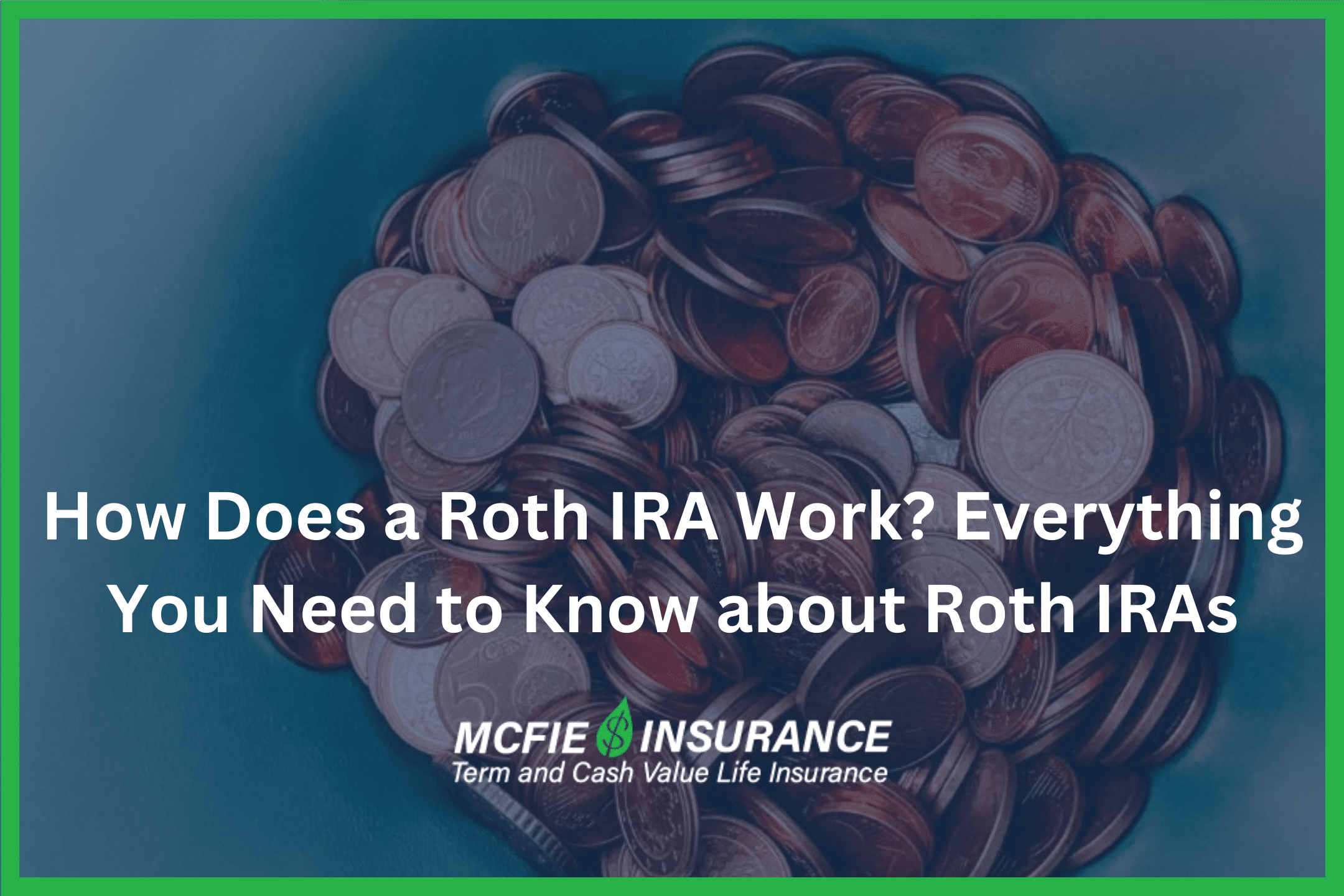702-660-7000
702-660-7000

A Roth IRA is an account which accepts non-tax-deductible contributions and allows tax-free growth for the entire life of the plan.
Roth IRAs were born in 1997 through the Taxpayer Relief Act. The bill was co-sponsored by Senator William Roth of Delaware and Senator Bob Packwood of Oregon. They designed the account to avoid existing congressional budget rules and give people a long-term tax break without feeling the cost in government budgeting for at least 10 years.
This background has encouraged many people to consider the Roth IRA an important tax loophole.

Get the knowledge you need to build sustainable wealth, and have peace of mind about your financial future. Order here>
A Roth IRA is a retirement savings account where you contribute after-tax dollars. The money grows tax-free, and withdrawals in retirement are not taxed.
Funding sources for a Roth IRA include:
Contributions must be made in cash, such as checks or money orders, not in securities or property.
The IRS sets annual contribution limits for all types of IRAs, including Roth IRAs. These limits are adjusted periodically and apply across all your IRA accounts, so the total contributions to multiple IRAs cannot exceed the maximum limit.
Unlike other retirement plans, Roth IRAs grow tax-free and are less restrictive. There are no required minimum distributions (RMDs) during the account holder’s lifetime, unlike with 401(k)s and traditional IRAs.
In contrast, traditional IRAs typically involve pre-tax contributions, offering a tax deduction upon contribution. Taxes are then paid upon withdrawal in retirement.
When you contribute to a traditional IRA, your contribution is tax deductible as long as you stay within the contribution limits and your income is also within certain limits.
There is no tax deduction for contributions to a Roth IRA. You still must comply with contribution limits and your income also must fall within the allowed limits, but once money is in a Roth IRA it can grow tax-free and you can withdraw all your contributions and growth tax-free as long as you follow the rules.
This makes the Roth IRA a great tool for investments with possible significant growth beyond original contributions to the plan. An investment within the plan could return 1000% or more and you would never have to pay income taxes on the growth.
Another way Roth IRAs differ from Traditional IRAs is: You CAN withdraw Roth contributions as a qualified withdrawal after they have been in the account for at least 5 years (remember you have already paid taxes on the Roth contributions). Tax treatment for Roth withdrawals is First-In-First-Out which means withdrawals come from contributions first and then earnings.
Withdrawal of earnings from a Roth IRA is not usually taxable but earnings would be taxable and subject to the 10% early withdrawal penalty for any non-qualified withdrawal of earnings before age 59 ½.
| Traditional IRA | Roth IRA | |
| Tax Deductible Contributions | Yes | No |
| Income Limits on Contributions | Yes | Yes |
| Required Minimum Distributions after age 72 | Yes | No |
| Tax free Withdrawals | No | Yes |
| Tax & Penalty free Withdrawal of Contributions after 5 years | No | Yes |
The major limitation of a Roth IRA has to do with the low contribution limits. As of 2024 contribution limits are only $7,000/year for most people ($8,000/year for people age 50 and older.)
Income limitations are based on your tax filing status and Modified Adjusted Gross Income (MAGI). The MAGI limits can change from year to year. As of 2024:
If you file taxes as a Single:
If you are Married Filing Jointly:
If you are Married Filing Separately these limits are significantly worse:
To get around contribution limits, high-income earners will often “rollover” a 401(k) or some other traditional retirement plan to a Roth IRA (sometimes called a backdoor Roth IRA) paying taxes in the process. This is not considered a contribution.
There are no income limits on rollovers to Roth IRAs, but you do have to wait 5 years to withdraw any funds after a rollover/conversion to a Roth IRA otherwise the earnings will be taxable and you face a 10% penalty if you’re under age 59 1/2. Most people who make a rollover to a Roth IRA do not wish to withdraw any money from the new plan for several years.
Some people are confused with the difference between a Roth IRA and a 401(k). There is even such a thing as a Roth 401(k).
Obviously, IRAs and 401(k)s are not the only investment options. There are a wide variety of retirement plans to choose from, or you can bypass both the access and investment restrictions inherent with all retirement plans and make your investments directly without tax-deferred benefits.
Some people are not good candidates for saving through retirement plans. This includes people who:
Certain types of participating whole life insurance can be structured to provide these people a high level of security and guarantees with many of the benefits of a Roth IRA, but no contribution limits and no limits on accessing their money. Life insurance is not considered an investment, so I will include some details on this strategy further down.
Roth IRA eligibility depends on income and filing status. To contribute, you must have earned income and meet specific modified adjusted gross income (MAGI) requirements.
Individuals whose annual income exceeds a certain IRS-determined threshold become ineligible to contribute. These income limits are updated annually.
| Category | Income Range for 2023 Contribution | Income Range for 2024 Contribution |
| Married and filing a joint tax return | Full: Less than $218,000 Partial: From $218,000 to less than $228,000 | Full: Less than $230,000 Partial: From $230,000 to less than $240,000 |
| Married, filing a separate tax return, lived with spouse at any time during the year | Full: $0 Partial: Less than $10,000 | Full: $0 Partial: Less than $10,000 |
| Single, head of household, or married filing separately without living with spouse at any time during the year | Full: Less than $138,000 Partial: From $138,000 to less than $153,000 | Full: Less than $146,000 Partial: From $146,000 to less than $161,000 |
The process works as follows:
Individuals earning below the specified range for their filing status can contribute the lesser of 100% of their compensation or the annual contribution limit.
For those within the phaseout range, the eligible contribution amount is calculated by subtracting their income from the upper limit of the range, then dividing this difference by the total phaseout range. This determines the percentage of the maximum contribution they can make.
Earnings in a Roth IRA depend on how much you invest, what investments you make within the plan and how those investments grow, minus the management fees.
Yes, you can lose money in a Roth IRA because the performance of the account is based on the performance of the underlying investments or other holdings in the account. You can also lose money with a Roth IRA if you take a non-qualified withdrawal. The penalty for non-qualified withdrawals is 10%.
Most people invest their Roth accounts in mainstream investments such as stocks, bonds and mutual funds, so the most commonly acknowledged cause of losing money in Roth IRAs, is due to market fluctuations and the timing of underlying investments.
Management fees can also cause large losses within a Roth IRA. Losses due to fees can be huge over a lifetime, even though the fees seem small at the time.
For example: A Roth IRA with $100,000 earning 5% each year could grow to $432,194 after 30 years. But with an average 1% annual management fee you will end up with $319,694 in the account. This is a loss of $112,500 even though you only paid $58,400 in fees. $112,500 – 58,400 = $54,100 of lost compounding opportunity in addition to the actual fees you paid.
Management fees are more subtle than investment losses, but they are an important factor to consider.
The first step to saving in a Roth IRA is to see if your income allows you to contribute to a Roth. This is an easy question for your CPA to answer.
You can also consider what options you may have available for a rollover from another retirement plan to a Roth IRA.
Next, you select a financial institution to open the Roth IRA. This company is also known as the IRA custodian. Ideally, you want to choose a custodian with a low management fee and which offers the investment options you want.
Filling out the paperwork to open a Roth account is easy. Information typically needed is a social security number, driver’s license, employer information and bank information. You will also specify a beneficiary at the time of opening a Roth account.
If you are starting a Roth IRA through a rollover, you should consider ahead of time whether you will do a direct or indirect rollover and what your tax liability will be.
High-income earners will often roll 401(k)s or other retirement plans to Roth IRAs, paying the taxes at the time of the rollover/conversion so they can make additional investments and harvest all the future growth tax-free.
Since a rollover avoids Roth IRA contribution limits, people can get a lot of money into a Roth IRA very quickly through a rollover, regardless of how much income they make.

An easy read and a perfect introduction to whole life insurance and The Perpetual Wealth Code™ Available in eBook or Audiobook format.
Download here>
When the investments you wish to make are available to Roth accounts, this strategy can work really well. Many prominent entrepreneurs have accumulated multi-millions, tax-free, in Roth IRAs including Max Levchin and Peter Thiel, co-founders of PayPal.
Multi-million Roth IRAs have raised concerns that the rich are getting out of paying their fair share of income taxes. The SECURE act of 2019 limits the ability for Roth accounts to pass tax-free growth to future generations by requiring distribution on inherited IRAs within 10 years after the death of the original account holder.
You’ll need to give up access to your contributions for at least 5 years, and also give up access to your earnings on those contributions for 5 years or until age 59 ½ whichever is longer to avoid the 10% early withdrawal penalty. There’s also the expense of an annual management fee to the custodian plus any fees on the underlying investments.
Lost opportunity is probably the biggest downside of a Roth IRA because access to your money is restricted, and so are the investments you can make within the plan. Investments in your business, or even a real estate investment where you would make do-it-yourself improvements, are off limits as an investment within your Roth IRA.
Many people who want to know more about what a Roth IRA is, and how they work, are also interested in whole life insurance structured for high cash value and long-term growth.
Whole life insurance premiums are not tax-deductible but the cash values grow tax-deferred and the death benefit is ultimately income tax-free. In these respects, life insurance is very much like a Roth account with no contribution or access limits.
Accessing the cash value in a life insurance policy is easy. Cash values can be leveraged via policy loan within the first year of a policy to about 60% of the value of the initial premium. By year 4-5 cash values can grow by more than the premium paid each year and the cash value in the plan is always accessible by policy loan.
Policy loans can be used for any purpose, and there are no limits on the types of investments you can make. You can fund a real estate investment with a policy loan, even if you plan to put “sweat equity” into the property.
The return on most investments funded through a policy loan will be taxable, but as long as the return is more than the policy loan interest, this can be productive over time.
Many people find it makes sense to use whole life insurance to build their financial foundation first and if they still want 100% tax-free growth on some investments through a Roth, they can add the Roth later, once they have strong liquidity through life insurance.
There is a “capitalization phase” for whole life insurance because it takes 7-15 years to recover the cost of all the premiums paid to that point. Also, from the very beginning, policy holders have a death benefit protection which is less costly than buying term insurance over a long period of time.
In retirement, tax-free withdrawals can be made from a whole life insurance policy up to the total premiums paid. The entire cash value of the policy (more than premiums paid by this time) can be leveraged via an interest only policy loan with no taxes. Withdrawals beyond premiums paid would be taxable, but there are other options for passive income involving life insurance which are usually better than a straight withdrawal.
If passive income is not needed from a whole life policy in retirement, the death benefit goes tax-free to your heirs which makes whole life insurance a great tool for building generational wealth.
At McFie Insurance we specialize in designing whole life insurance to maximize cash value for clients. Schedule an appointment to see what a well-designed whole life insurance policy would look like for you.
 by John T. McFie
by John T. McFie
I am a licensed life insurance agent, and co-host of the Wealth Talks podcast.
At age 14 I started developing spreadsheet models and software systems to help my Dad share financial concepts with clients.
Skipped college at 17 recognizing the overinflated value and prices of most college degrees and built more financial software instead (see MoneyTools.net). Still a strong advocate of higher education without going to college. I enjoy making financial strategies clear and working through the numbers to prove results you can count upon.